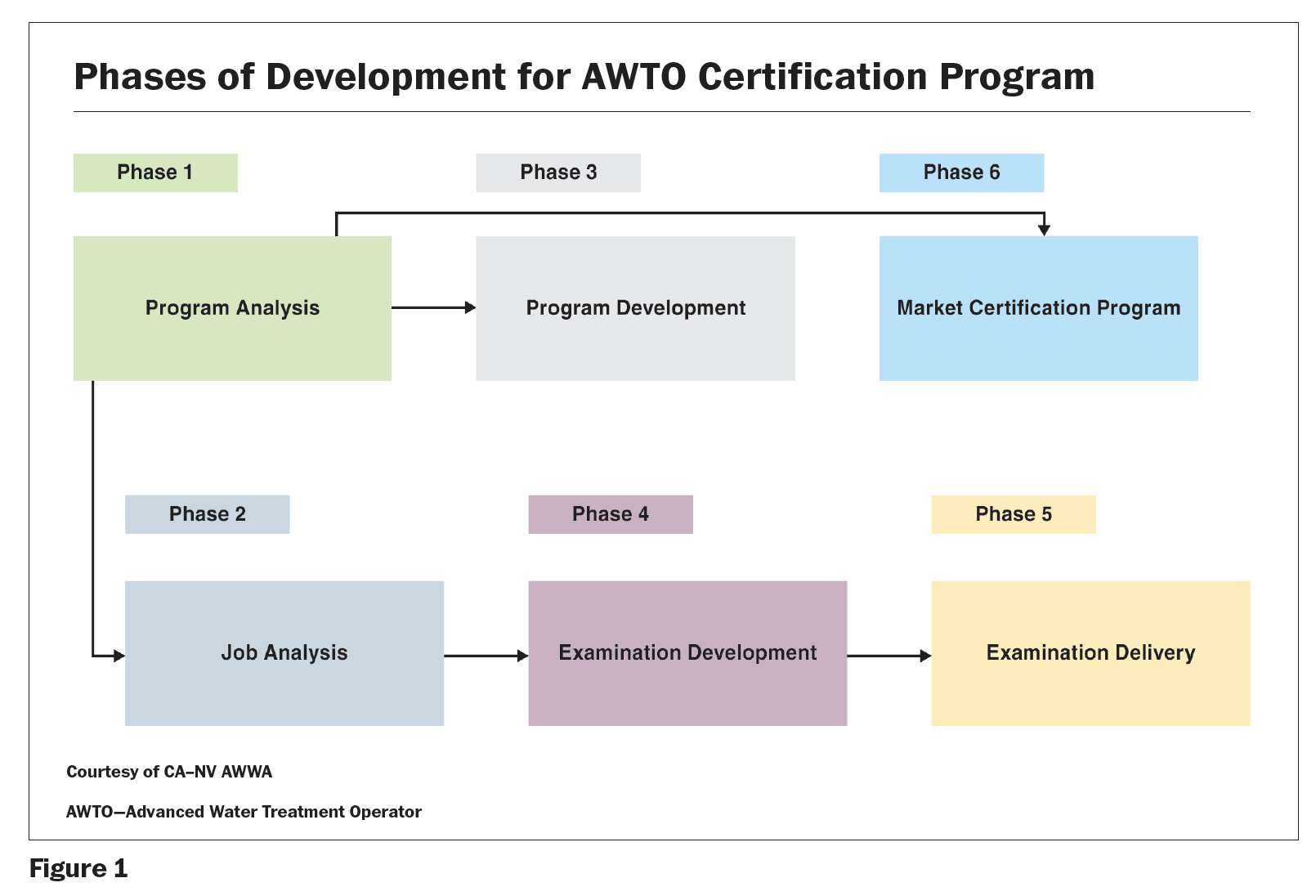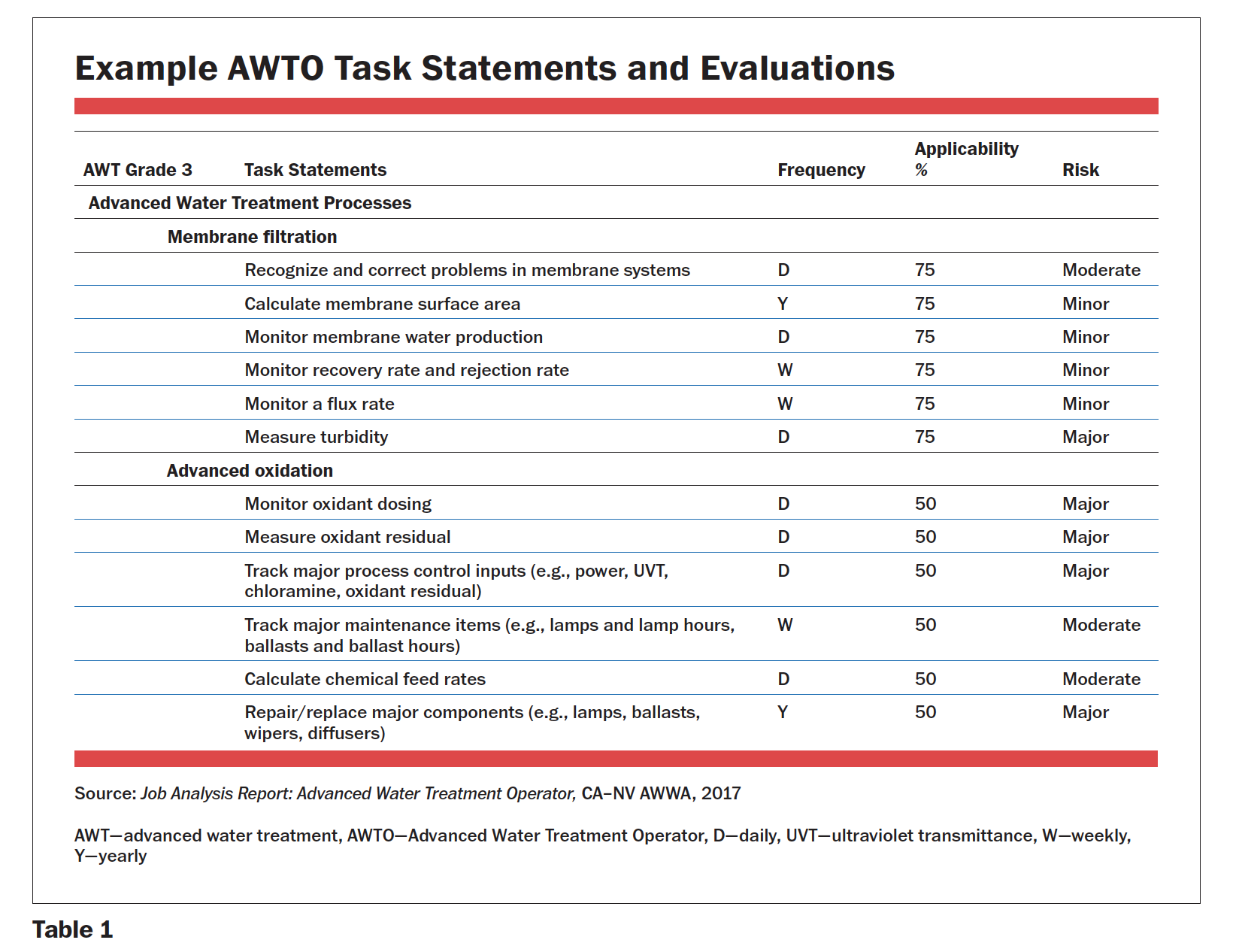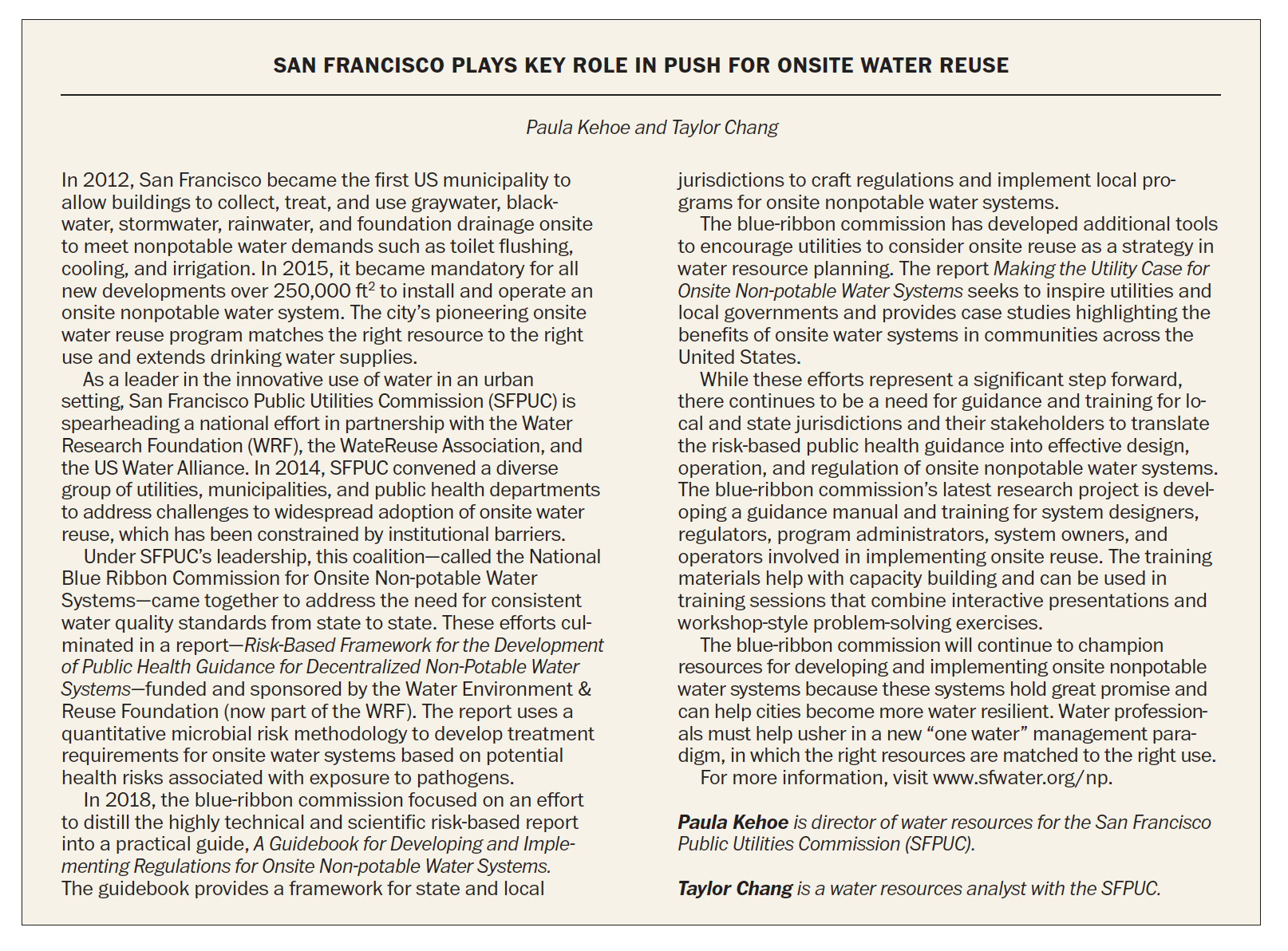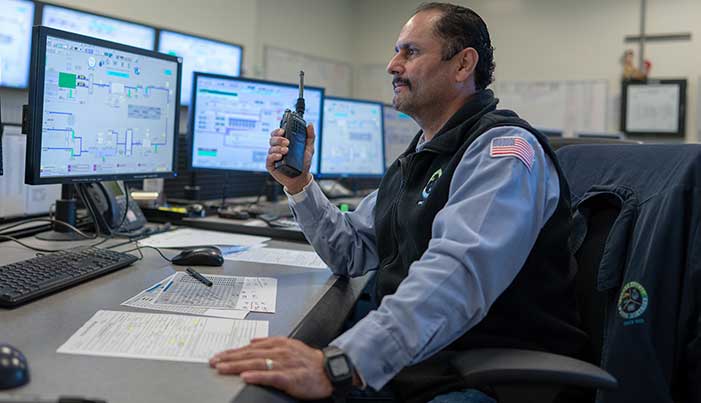The following has been reformatted and republished with permission from September 2019 Journal AWWA (Vol. 111, No. 9). Copyright AWWA 2019. All rights reserved. The original article may be accessed on the Journal AWWA website at https://awwa.onlinelibrary.wiley.com/journal/15518833
By Steven Garner
Certification Manager
CA-NV AWWA
Key Takeaways
The California–Nevada Section of AWWA and California Water Environment Association sought a new industry certification for operators working with advanced water treatment (AWT) processes.
A diverse set of stakeholders and experts added their perspectives on the development of the new certification.
The AWTO Grade 3 exam was released in July 2019.
Water has been reused since ancient times, primarily resulting from upstream users discharging their waste into rivers, lakes, and other water bodies. Over time, nonpotable reuse gained popularity to meet irrigation and industrial demands. So, while overall reuse is not new, intentional potable reuse (i.e., treating wastewater historically released into the environment so that it meets drinking water standards) is still a relatively novel approach to water supply for almost all utilities.
In California, six treatment plants are purifying or treating wastewater for use as a drinking water resource. Typically, treated wastewater is directed into reservoirs or underground aquifers, which serve as environmental barriers that provide dilution and natural attenuation.
Managers and board members of these innovative utilities shared a common concern—namely, how to increase community confidence in the processes used to treat wastewater. Regulators, consumers, and nongovernmental organizations have raised concerns about pathogens and other harmful constituents, as did the staffs and leaders of the utilities looking to incorporate potable reuse.
Industry associations developed operator certifications for conventional water treatment several decades ago. For example, AWWA and its sections created the Drinking Water Treatment and Distribution Operator certifications as a way of demonstrating the competence of those vital water industry roles; the Water Environment Federation and its member associations created the similar Wastewater Treatment Plant Operator certification.
In the United States from 1970 to 2000, individual states were responsible for issuing either certifications or licenses for drinking water and/or wastewater operators. Industry associations remain active in developing and refining credentials (e.g., certification and certificate programs) relevant to the needs of their members and the overall water community.
Members of the California–Nevada Section of AWWA (CA–NV AWWA) sought a new industry certification for operators working with advanced water treatment (AWT) processes for potable reuse. Operators in California and Nevada are currently tested for their understanding of conventional treatment and common operations. In California, the industry surveys thousands of operators to determine what the state operator exams will cover; areas that are common among 60% or more of the operators surveyed may be present on the exam. AWT processes include microfiltration/ultrafiltration, reverse osmosis, granular activated carbon, and membrane bioreactor; these treatment techniques are only used by approximately 10% of operators, so the California and Nevada state operator exams did not contain many items addressing them.
Brian Bernados, a senior sanitary engineer with the California State Water Resources Control Board’s Division of Drinking Water, said, “The current operator certification programs do not sufficiently address advanced water treatment processes such as ultraviolet disinfection, reverse osmosis, and advanced oxidation. These advanced treatment technologies are critical to protecting public health while addressing California’s future water supply issues that involve potable reuse and other impaired sources. The wherewithal required to operate increases with the complexity and sophistication of the system, especially as potable reuse goes from indirect to direct potable reuse.”
CA–NV AWWA conducted a survey in 2014 to determine the level of interest in new industry certifications, including for advanced treatment processes and recycled water operations. A total of 470 operators responded to the survey. Two noteworthy findings:
About 50% of the respondents found that a new certification for AWT operators would be encouraged or required for their operators.
Sixty-five percent of the respondents found a range of benefits to their operations from operators having an AWT Operator (AWTO) certification.
These responses confirmed the market’s need for a new voluntary industry certification.
Additional Operator Certification Research
The Water Research Foundation (WRF) funded multiple projects to define appropriate knowledge, skills, and abilities required by AWT operators. Two of the most notable are
Project 13-13: Development of an Operation and Maintenance Plan and Training and Certification for Direct Potable Reuse Systems and
Project 15-05: Curriculum and Content for Potable Reuse Operator Training.
WRF chief executive officer Peter Grevatt said, “The WRF looks forward to continuing our support for this certification program through the use of our research projects and products that will help answer the pressing questions on potable reuse and advanced water treatment processes.”
In February 2016, California Urban Water Agencies (CUWA) produced a white paper, Potable Reuse Operator Training and Certification Framework. It was developed on the basis of a survey of 64 water agencies as well as a workshop that was held in October 2015. Together, the survey results and the workshop findings reinforced the notion that a new certification addressing the role of an AWT operator was supported by regulators, drinking water and wastewater plant management and operators, and other stakeholders.
As noted in the white paper, potable reuse system operation for groundwater recharge and surface water augmentation is different from conventional wastewater and water treatment operations in several important ways:
Potable reuse requires multiple barriers using a variety of technologies and a more complex treatment train than conventional water and wastewater treatment processes.
Given that source water is treated secondary or tertiary wastewater effluent, it is critical that all components are operated and maintained as intended.
Feedwater quality (both raw wastewater into the [wastewater treatment plant] and secondary or tertiary effluent feedwater to the AWT process) can vary significantly, which can impact the daily operation of the advanced treatment plant and potentially the purified water quality.
Potable reuse is not regulated under any one existing federal program.
The California State Water Resources Control Board convened an expert panel to advise on developing uniform recycling criteria for indirect potable reuse (IPR) via surface water augmentation and on the feasibility of developing such criteria for direct potable reuse (DPR). As found in the published feasibility report, the expert panel concluded the following:
If certification for potable reuse operators is not part of the California Water Code, requirements should be included as a permit condition issued for these facilities. The development of a [DPR] certification program would benefit from the experience of certified operators at existing AWTFs [advanced water treatment facilities] for [IPR]. The certification program could be administered by the State Water Resources Control Board or by water industry trade associations experienced in implementing operator certification and training programs; however, the state water board should be involved in the development of any industry certification process.
Industry support from both drinking water and wastewater operations perspectives contributed to the definition of the certification for AWT operators. While both IPR and DPR operations will benefit from a new certification addressing the AWT processes, conventional treatment plants may also seek operators with the new certification. Facilities with one or more AWT processes will see the advantages of employing treatment plant operators who have passed the additional assessment of the Advanced Water Treatment Operator (AWTO) certification program.
Ingrid Bella, general services manager with Valley Water, said, “If the future of potable water is to include reuse, then it is imperative that the industry train its employees to the highest possible standards. Testing and certification is an effective way to provide the public confidence and to create a career pathway for water operators dedicated to the highest standards of water purity and public health.”
The AWTO certification is the first program combining drinking water and wastewater treatment proficiencies for operator certification/licensing in a single assessment. One of the peripheral benefits of this program is that facility operations may be enhanced when operators gain a more thorough understanding of treatment challenges presented from both sides of the water cycle. Additionally, operator mobility may increase as individuals are prepared to oversee a variety of treatment trains using AWT processes. Ultimately, this next generation of operators will possess a broader understanding of regulations, treatment challenges, and operational considerations when using freshwater sources or reuse.
Elizabeth Allan, executive director of California Water Environment Association (CWEA), said, “The [AWTO] certification is a true mark of cooperation within our sector. State regulators, water utilities, and several operators called for the creation of a new certification program. CA–NV AWWA and CWEA members, subject matter experts, leaders, and staff pulled together and got it done.”
Developing the AWTO Model
CA–NV AWWA is a member-driven organization that relies mainly on volunteers to provide guidance and training to its members and the larger water communities in these states. CA–NV AWWA formed a committee to explore AWTO certification in 2015 following recommendations from its governing board, staff, and volunteer leaders based on involvement with facilities using AWT processes. Ultimately, 30 volunteers accepted the invitation to form an ad hoc AWTO certification committee.
Jack Bebee, assistant general manager with Fallbrook Public Utilities District, said, “When a group of us saw the direction a number of studies were headed that highlighted a concern over the need for more robust operator requirements for operations of advanced water purification facilities, we saw CA–NV AWWA and its engaged membership mix of engineers and operators as the best conduit to address this concern.” Bebee said that the section’s ad hoc advanced water treatment committee was formed as a result. Rather than relying solely on the regulatory community, operators, engineers, and regulators with expertise in advanced treatment technologies collaborated to develop the advanced water treatment certification program.
The committee primarily focused on developing a certification program that protected public health through an assessment designed to determine the minimum competencies operators would need as a certified AWT Operator. Engaging state and federal regulators in the AWTO certification committee at the outset helped keep the program in line with current and potential regulations. Gaining the confidence of regulators was considered key to acceptance of the new operator certification offering.
Bernados, of the California State Water Resources Control Board, said, “Working on the committees from the start with the leaders in this field, I have seen the emphasis on protecting public health. Experienced and highly capable operators are needed for IPR and DPR. The process has been carefully and thoughtfully discussed, analyzed, and developed.”
The ad hoc AWTO certification committee accepted responsibility for a complex set of business processes as reflected in the workflow diagram (Figure 1). Each process phase was addressed by a work group from within the committee that focused on the deliverables defined for the phase of work. CWEA also collaborated with CA–NV AWWA to create the new AWTO certification program. Ultimately, a diverse set of stakeholders and experts added their perspectives on the development of this new voluntary industry certification.
Practice Analysis
Subject matter experts (SMEs) conducted a practice analysis (i.e., job analysis, or task analysis) to define the knowledge, skills, and abilities that advanced water treatment operators must demonstrate. As the practice analysis was performed, psychometric guidance was included. (Psychometrics is the science and technology of mental measurement, including psychology, behavioral science, education, statistics, and information technology.)
At a workshop in May 2016, SMEs defined task and knowledge statements; this was followed by an informal survey of incumbents to verify and rank these findings. A second set of SMEs was convened to verify this work at a workshop in October 2017. Members from CA–NV AWWA and CWEA participated in verifying and ranking the task statements.
During this process, the task and knowledge statements were refined (see sample task statements in Table 1). Each task statement was rated across three categories:
The applicability of the task (percentage of the AWT operator population that would perform the task)
The frequency of the task (daily, weekly, monthly, yearly, never)
The risk mitigated by good performance of the task versus poor or no performance of the task (critical, major, moderate, minor, or not applicable)
At each grade level, the criticality of each task was defined as the product of the frequency, applicability, and risk ratings, where risk was assigned an ordered numeric value (i.e., a weighting value). Table 1 shows examples of the task statement depth, and a similar framework was created within each domain across all three grade levels. The final practice analysis report was issued for public release in September 2017 (available from the author by request).

Exam Development
In December 2017, CA–NV AWWA and CWEA signed an initial memorandum of agreement (MOA) to develop three AWTO certification grade-level exams (3, 4, and 5); they were chosen to correspond with these levels of drinking water treatment operator certifications within the current State of California Office of Operator Certification program. (Nevada uses four levels for drinking water treatment operators.) The intent is to rely on state drinking water and wastewater treatment operator certifications at the grade 3 level to qualify to sit for the AWTO certification grade 3 exam (AWT3) in both California and Nevada.
SMEs were guided through the exam development steps, again considering psychometrics. Each SME selected specific task statements from the previous framework for each grade level to address any outstanding questions. Following SME review, the subsequent refinements were again evaluated against psychometric standards to ensure that the overall blueprint that was followed led to the definitions and that the evaluations were mechanistically sound independent of their technical requirements.
All items were collected and grouped by task statement and aligned with the domains. The number of items required for each grade level that met the blueprint expectations and satisfied the SMEs that a candidate’s competence was adequately measured was determined with consideration of the time for a candidate to respond. The AWT3 grade-level exam will have 100 items, the AWT4 grade-level exam will have 85, and the AWT5 grade-level exam will have 70.
Many credentialing organizations use the modified Angoff method for their standard-setting process, which uses expert judgments to determine the difficulty level of a test. A passing score is determined for each item through evaluation by SMEs and for performance on the exam as a whole.
 Implementing the AWTO Certification Program
Implementing the AWTO Certification Program
CA–NV AWWA funded the early phases of the work. An amount of $200,000 raised from stakeholder organizations paid for workshops, consultants, and marketing expenses. Exam revenue and renewal fees are expected to permit the program to become self-sustaining.
Sharing the responsibilities for governance of the full program development and maintenance required extensive collaboration between CA–NV AWWA and CWEA. Staff and volunteer leaders formed a group to provide strategic and tactical direction. In November 2018, both executive directors signed a supplement to the exam development MOA addressing a range of governance and administration duties.
Each association contributes staff and volunteer leaders to tasks in support of the volunteer AWTO certification committee. CA–NV AWWA will administer the overall program, which involves application processing, candidate scheduling, and certificate issuance. CWEA leads the fundraising as well as the marketing and communication activities.
The AWT3 was released in July 2019. Before the release, a candidate handbook with information necessary to apply to sit for the exam and the policies governing the certification program was published. Applications were available in May 2019 for interested grade 3 treatment operators (drinking water or wastewater). The AWT4 and AWT5 certification exams are expected to be released by October 2019.
Workforce Development
There is demand for highly trained operators for centralized and decentralized water treatment; in California, more than 40 utilities are considering or taking actions toward developing potable and nonpotable reuse water treatment facilities. The expected growth in the number of AWT systems means more highly qualified operators will be needed, so the water industry must plan for their education and certification.
Some states are grappling with how to address education and work experience gained outside of state-permitted treatment plants (e.g., military/industrial treatment operations; see California Assembly Bill 1588). Legislative and regulatory changes may be required to fully address the changing face of water collection, treatment, and distribution.
The National Blue Ribbon Commission for Onsite Non-potable Water Systems seeks to address similar needs for operators outside of traditional water industry scenarios (see the sidebar on page 59). Associations such as the Southwest Membrane Operator Association, CA–NV AWWA, CWEA, and others offer courses and workshops to prepare operators to meet these needs.
WRF Project 15-05 developed education content to prepare operators for DPR operations. The California State University, Sacramento (CSUS), Office of Water Programs (OWP) prepared updated instructional material covering the contents of the AWTO certification job analysis and WRF Project 15-05. Workshops and courses are expected to come online to prepare operators for the future of water treatment. Continued training and certification for centralized and onsite operators will help ensure the protection of public health, wherever the water treatment occurs.

Collaboration Pays Off
Wide support from across the water industry made the new AWTO certification exam possible. Regulator participation from state and federal levels provided insights for these efforts. Committee members represented all phases of plant operations, including operators, supervisors, managers, consultants, and more. Angela Cheung, Jack Bebee, Gordon Williams, Toby Roy, and Erin Mackey shared committee officer duties. Additional groups involved in this process included CUWA, WRF, and the CSUS OWP, along with the state of California and the state of Nevada.
“It has been a pleasure to work with so many dedicated individuals on the AWTO certification program,” said Bernados, a member of the blue-ribbon commission. “Operators, managers, and consultants have recognized that it is critical to protect public health by properly training and verifying the AWT processes are operated properly. This AWTO certification program will set the groundwork for future DPR regulations in California.”
Industry credentials assess a candidate’s minimal competence to perform in a given profession. As the role of a water treatment plant operator becomes more advanced, so must the training. The AWTO certification will address the growing need for operators of potable reuse plants that ensure public health protection. Credentialed operators will also be needed for nonpotable water reuse systems and nonmunicipal applications.
Like previous industry-led certifications, the AWTO program started out as a regional offering; other regions will benefit from this work if they adopt similar exams for their jurisdictions. Eventually, the state of California, the state of Nevada, or the Association of Boards of Certification may take over the innovative role being filled today by the CWEA and CA–NV AWWA. Whatever direction the program takes, the water industry will be better for these initial efforts to create an AWTO certification program.
About the Author
Steven Garner is the certification manager for the California–Nevada AWWA Section, Rancho Cucamonga, Calif. (www.ca-nv-awwa.org/); SGarner@ca-nv-awwa.org.

